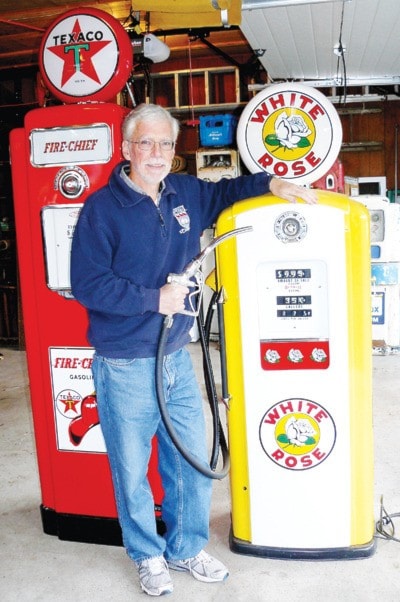G
eoff Stubbs pulls up to the gas pump for a fillup, there’s a good chance he pays a little more attention than most.
However, the retired teacher is not calculating the tenths-of-a-penny savings between one station or another or how clean the restrooms are.
Rather, he’s looking at the pump.
That’s because the Qualicum Beach resident knows quite a bit about gas pumps. In fact, he has about a dozen of them in his garage — and even one in his house.
“I’ve always been into old cars and I have a Model T that I’m working on,” he said. “It was a natural progression. I saw my first really painted up gas pump at The Old Spaghetti Factory and then one day I was looking for car parts and saw some pumps.”
Most of his gas pumps wouldn’t be familiar to most people, dating as they do to the 1940s, ‘30s and even earlier. The oldest in his collection — a Gilbert and Barker — dates back to 1908, just a few short years after automobiles were invented.
“It’s kind of neat to be able to pull something apart, refurbish it and make it look like it used to be,” he said.
“Most of them are in pretty bad shape and they need a lot of tweaking, so I take everything off, sandblast the frames, prime and paint everything and all the body panels come off and I get them done at a paint shop.”
These often overlooked pieces of history, he said, were instantly alluring and he began collecting in earnest.
“I spent two summers on the prairies, picking pumps,” he said.
“There are a lot of abandoned towns on the prairies and a lot of pickers picked them clean.”
Stubbs looked on collector websites prior to his pump picking adventures, lining up appointments at isolated farmsteads, collectors’ homes and tiny towns from Alberta to the Manitoba border.
The pumps in his collection are a diverse lot, some with hand pump systems from areas where electricity was slow to arrive, some with glass cases where drivers would watch the amount of gasoline they were purchasing and even one — his favourite — with a clock face-style gauge.
“These weren’t used for very long, about four years,” he said. “They were the technology between the visibles — where you could actually see how much gas you were pumping — and the calculating ones, that came in about 1936.”
The visibles, he added, generally used a gravity feed and drivers of the day knew it was best to fill up on a cold day, so they would get more volume for their money.
Collecting gas pumps may be unusual, but there’s an active community of pump people who write books — The Illustrated Guide to Gas Pumps and Gas Pump Collectors Guide are two he owns — maintain websites and even go to the occasional convention.
“The ones that everyone strives to have are the double ones,” he said. “They’re expensive. With a fully restored one you’re looking at $15,000.”
The most expensive pump Stubbs owns is his clock face model, which would sell for less than half that figure, despite its classy brass fittings and pristine condition.
Although his pumps don’t look much like the sleek units that are currently filling up cars in Oceanside, he said there are some consistencies — besides the fact that they all pump gas.
“There were four main producers in Canada,” he said. “There’s the Wayne, Gilbert and Barker, the Bennett and the Bowser. I have a Wayne pump from the 1930s and I went down to the Shell station at Memorial and they just got new pumps down there and they’re still made by Wayne.”
Stubbs is putting a couple of his pumps on the market he said, not because he has lost interest in his hobby, but rather because he has some very shabby pumps he wants to restore and he needs to free up room for them.
Looking around at the tall, short, slim and squat, colourful and drab pumps surrounding him in his garage, Stubbs sums up why he loves his unique hobby.
“There’s history here,” he said.
